Q. What timepiece did Ronald Reagan give to Mikhail Gorbachev as a gift? Which global time display appeared in the movies “Clear and Present Danger,” “Patriot Games,” and “The Hunt for Red October”?
A. Geochron.
The first Geochron, a wall-mounted device used to display the time anywhere in the world, was produced in 1965 by James Kilburg. He was a mechanical engineer who devoted his life to creating innovations such as the car cigarette lighter, the first automatic dialing telephone, an automated maraschino cherry pitter, and the Geochron World Clock.
The Geochron World Time Indicator, as it was known in its early days, was an electromechanical device that used a system of gears and a moving map to illustrate the Earth’s rotation and the distribution of daylight. It would show the current time across the globe, the distribution of daylight, and the Earth’s terminator line—the boundary between day and night. About 2 by 3 feet in size, it was a Mercator projection of the world framed for wall hanging. The colorful map itself was an endless belt that was driven slowly from left to right by an electric clock motor, synchronized with the Earth’s rotation.
Going Digital
At the time of this article (July 2025), the mechanical clocks start at $2,895.00, which is pricey for a station accessory.
The good news is that Geochron released a more affordable digital version in 2018. It projects the same sweeping arc of day and night but now in 4K resolution—suitable for modern flat-screen TVs and computer monitors. The most recent model, Geochron Digital Atlas 2 4K, can display a dozen map styles and update itself via Wi-Fi while showing you which parts of the world are basking in the sun and which are shrouded in darkness.
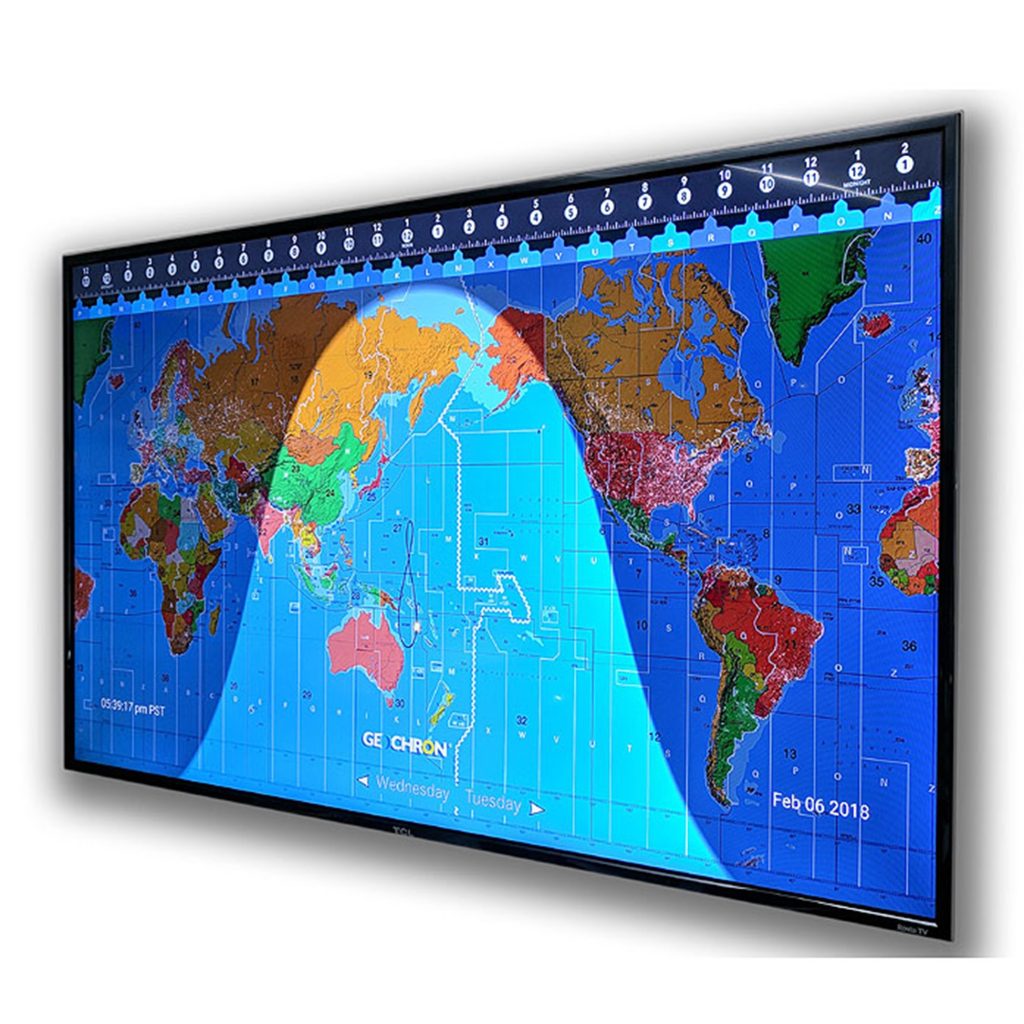
The digital Geochron’s mini-computer connects to a 4K display and renders an interactive, high-resolution map of the Earth. This map provides comprehensive information, including day/night shadows, the gray line (the transition between day and night), time zones, and satellite tracking. Adjustments can be made to local time zones. You can also display the UTC and local time and date simultaneously using the 12- or 24-hour format. Local and UTC time can be configured independently.
Hardware consists of the Azulle Fanless Mini PC Stick that connects to your TV or monitor via HDMI. Once installed, it delivers impressive, layered geographic data in 4K resolution along with a lower-res 1080p HD setting.
I highly recommend a 4K monitor—you can get one these days for a few hundred bucks or so. You’ll appreciate the improved resolution.
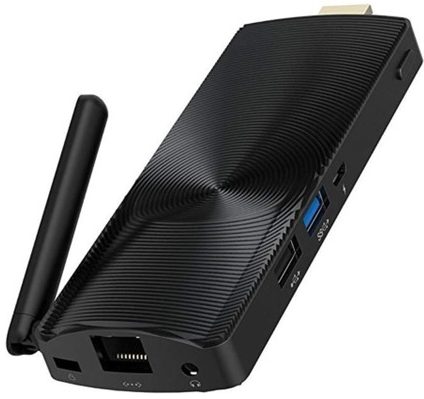
Initial Setup
Setting up the basic hardware takes only a few minutes. Begin by plugging in the power supply and attaching the power lead to the mini-computer. Run the video patch cord between your TV or monitor and choose an HDMI input. When turning on the Geochron Digital Atlas 2 4K for the first time, you must connect to the Internet using the Wi-Fi or Ethernet connection through the configuration menu. Once completed, you can download the software and updates.
Return to the menu for selecting layers and one of the multiple map styles, such as topographical/relief, night-time view (city lights), and satellite imagery.
Here’s a summary of the standard built-in features:
- Time—UTC, local time, sunrise/sunset
- Geography—city locations, political boundaries, selectable map configurations
- Solar—day/night line, solar flux, SFI, K-index
- Environmental—earthquakes, volcanoes, light pollution
- Space—satellite tracking, ISS, moon phase
Ham Bundle
The Ham Radio Bundle Layer is the star attraction of Geochron’s system for radio operators who want a wealth of information on a single screen. It’s not included in the basic package and has subscription fees, though there’s a free five-day trial period to try it out. As of July 2025, the Ham Radio Bundle subscription service starts at $6.99 per month or $69.99 for a year. You can also get a preview video and screenshots at the Geochron website to decide if this option is right for you.
Editor’s note: The Ham Radio Bundle is not sold by DX Engineering. It must be purchased through Geochron.
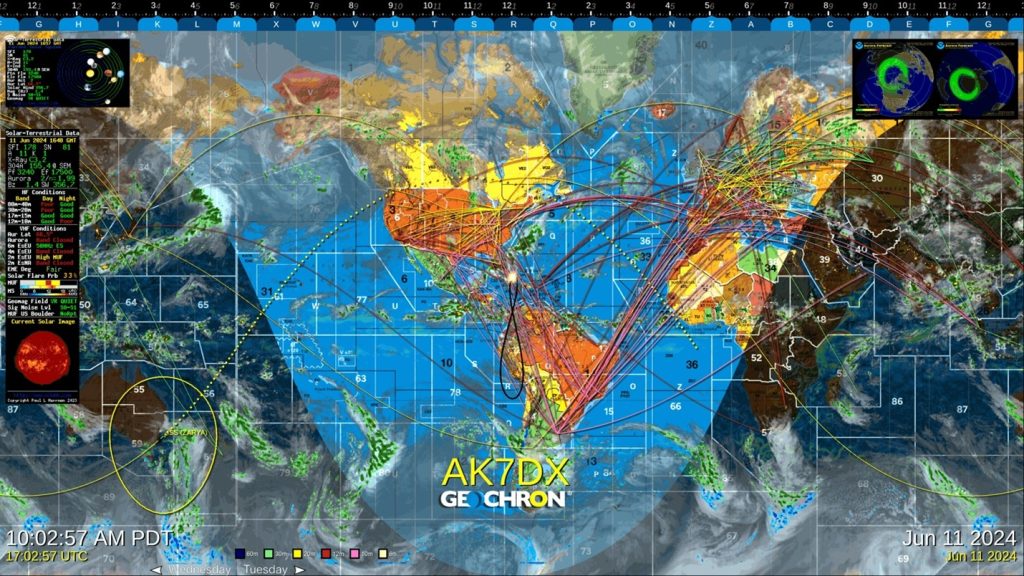
The Ham Bundle is a specialized setup designed for amateur radio enthusiasts who like real-time integration of geographic and temporal data with their radio operations. Imagine finding all the information you need about Maximum Usable Frequency (MUF), solar conditions, where contacts are happening and more, all in one place in real-time–complete with map locations.
No need for jumping to multiple websites for information. By visually displaying day/night zones and solar conditions, operators can better understand when and where to aim for contacts worldwide. It’s especially popular among those who enjoy understanding the connections between geography, solar conditions, and global communications.
Here are some of the ham radio features currently available:
- ADIF Call Log displays call signs of up to 1,000 stations you have contacted based on ADIF log files you upload through Geochron’s website. You can select the contacts to display based on parameters such as band, call sign, country of station worked, or time of contact (e.g., last hour, last day, last week, and so on). This is the functional equivalent of sticking pins into a world map to show stations you’ve contacted.
The ADIF files generated by most logging software should work without any issues. Automatic sync with the QRZ.com logbook is also available. - AMSAT Satellite Tracking provides the location of current amateur satellites with FM and/or linear transponders with a footprint circle to help you know when they are within range.
- Maidenhead Grid overlays the Maidenhead fields (the first two characters of a grid locator— DN, EN, FN, and so on).
- DX Cluster and Beacon Activity lets you watch global DX, FTC, WSPR, and RBN traffic by band in real-time, dynamically updated in as little as 15-second intervals within LF, HF, UHF, and VHF bands.
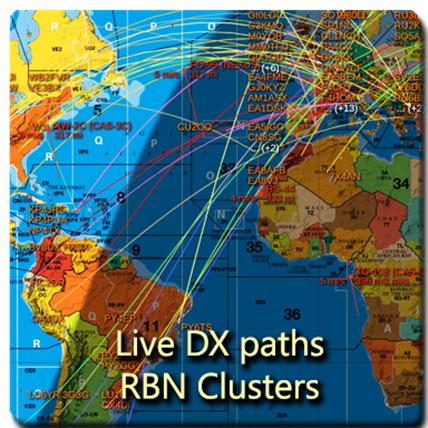
- Solar and Ionospheric Conditions lets you review on-screen widgets showing Solar-Terrestrial data; HF and VHF open/close conditions; and geomagnetic, solar flare, and aurora forecast.
- Maximum Usable Frequency provides an on-screen topographical and color heat-map profile of MUF around the world, showing the highest frequency available for ionospheric skip propagation using predictive models from the NOAA and Lowell Global Ionospheric Radio Observatory.
- Call Sign Display lets you add your call sign to the clock screen above the Geochron logo. Font, type size, and color are all adjustable. Center the display on your QTH.
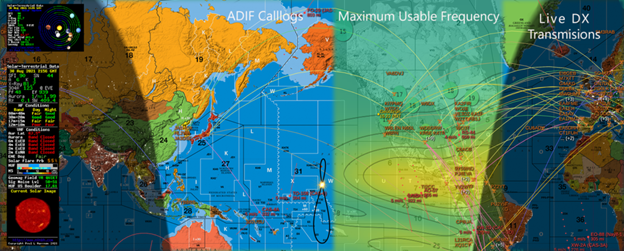
The Ham Map Bundle draws from various online sources to keep data up-to-date and relevant, including the NOAA for solar conditions, ham radio databases for station activity, and DX spotters.
Eye Candy
Building on the legacy of Geochron’s mechanical clocks, the Geochron Atlas 4K offers a modern, digital alternative. It combines advanced mapping software with a compact plug-and-play device capable of outputting 4K content to any compatible monitor or TV. Even if you don’t require all the information available, it’s a cool thing to watch.
As a Geochron fan from nearby Canton, Ohio, said, ”It’s mesmerizing, like an aquarium.”
***
Editor’s note: Watch this video from DX Engineering’s YouTube channel featuring Tim Duffy, K3LR, DX Engineering CEO, interviewing Geochron owner, Patrick Bolan, KJ7ZSU, who displays features of the Ham Map Bundle.

